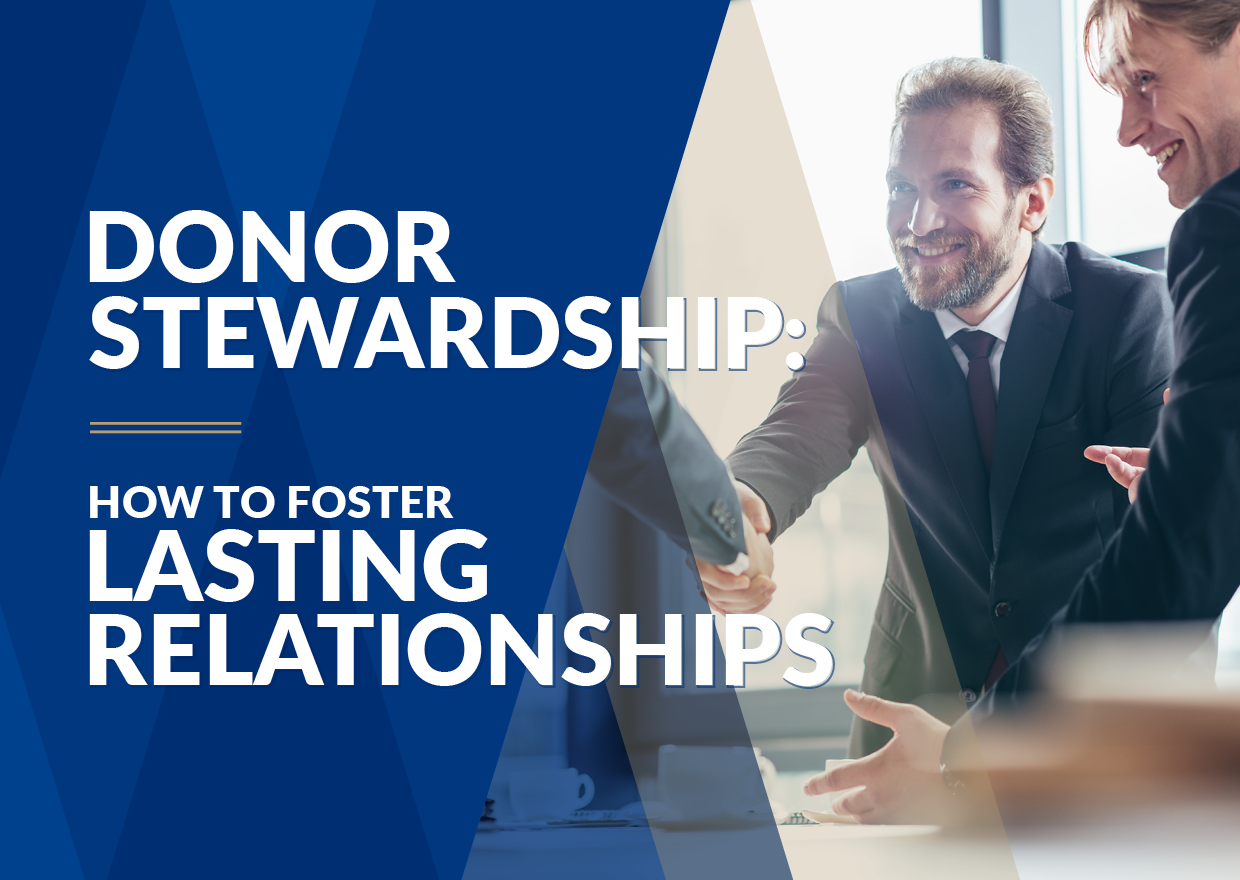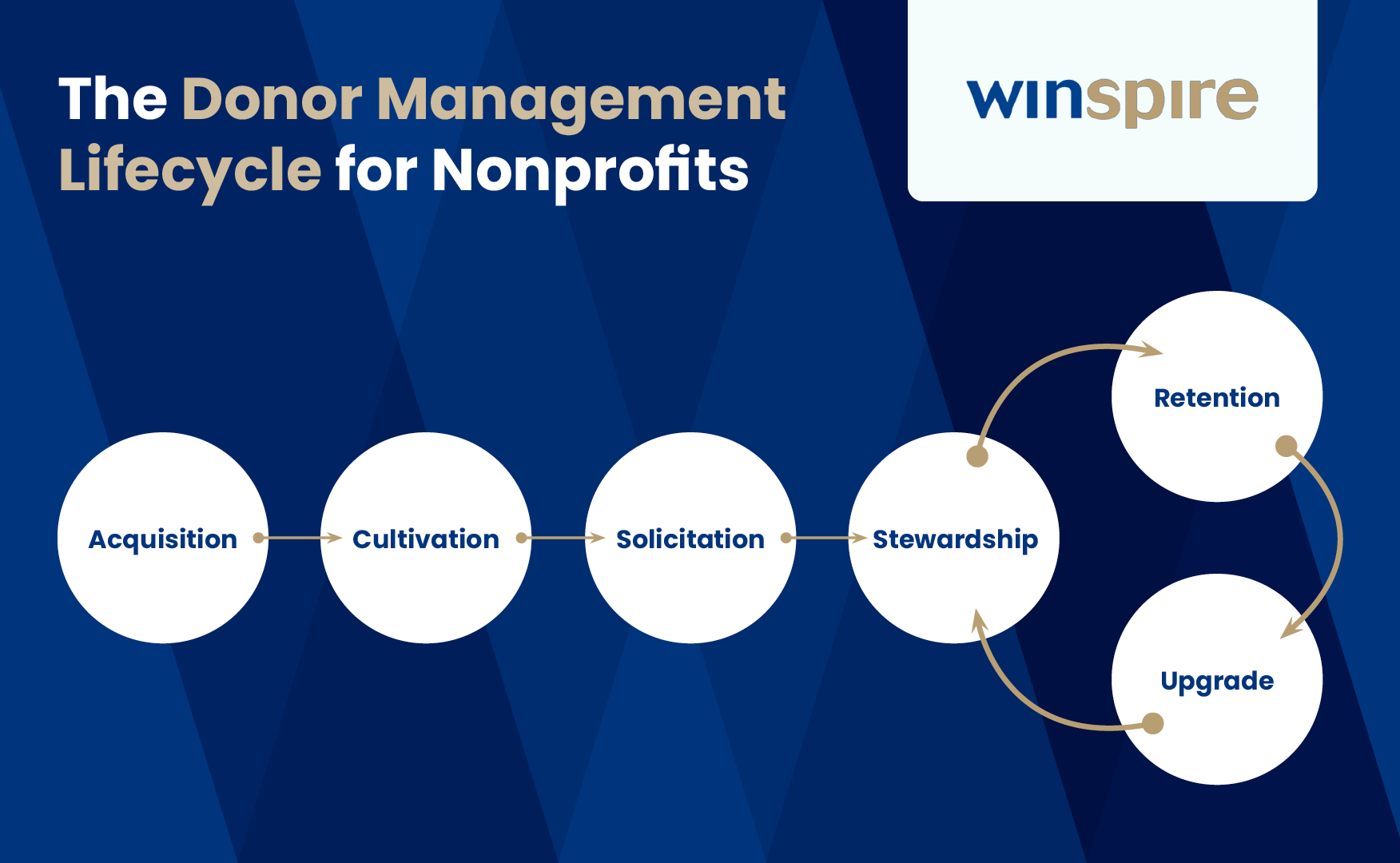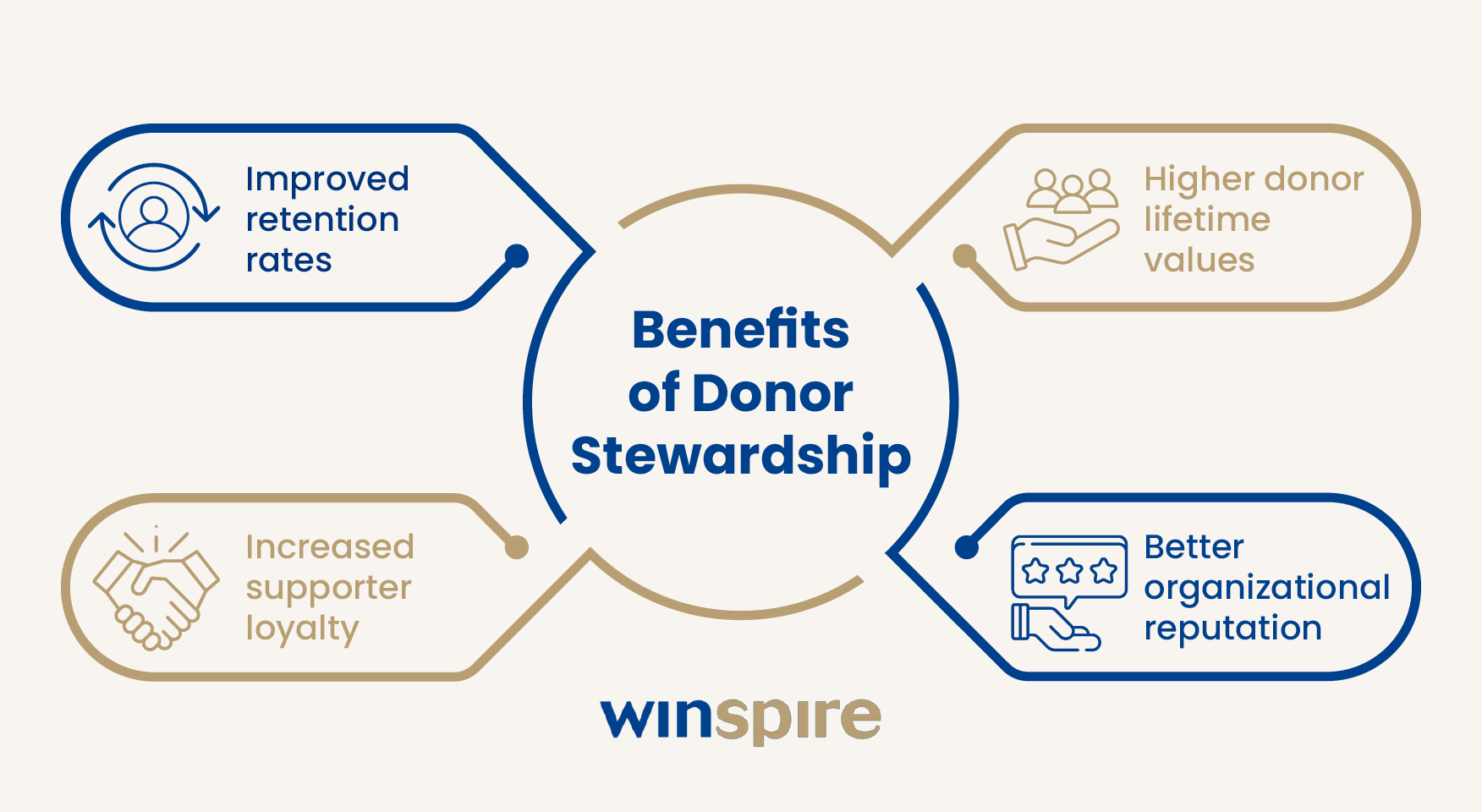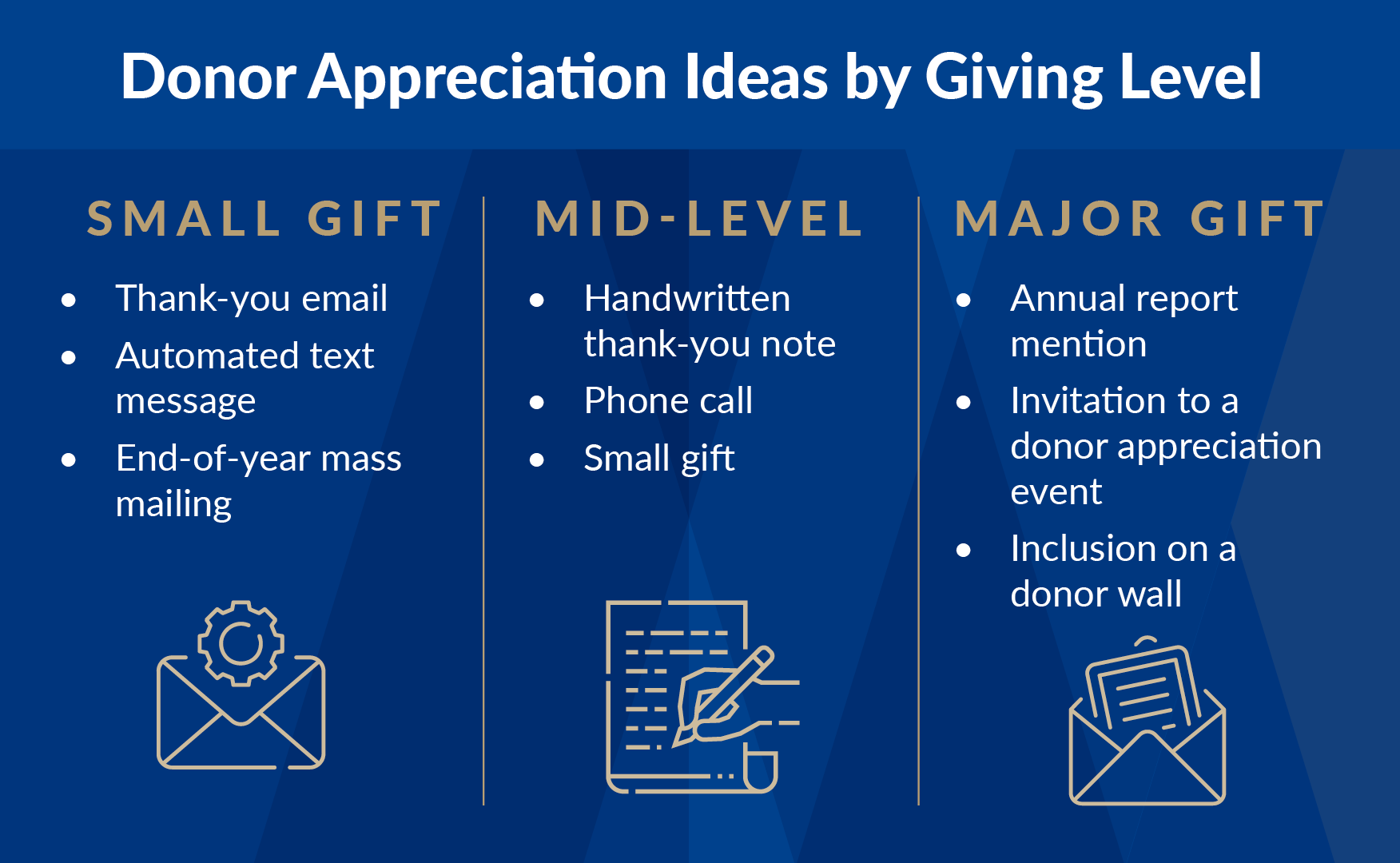The key to your nonprofit’s fundraising success is sustainability. While attracting new supporters before each event or campaign can help you achieve your goals, keeping donors engaged after their initial contribution will create a reliable support base for your organization.
Maintaining donor engagement starts with showing that you appreciate and value each supporter’s involvement with your mission—which is where donor stewardship comes into play. In this guide, you’ll learn all you need to know to develop an effective stewardship strategy for your nonprofit, including:
- What is donor stewardship?
- Benefits of Donor Stewardship
- Steps to Create a Donor Stewardship Plan
- Additional Pro Tips to Steward Your Supporters
Let’s get started with an overview of what donor stewardship is and how it fits into the larger supporter journey.
What is donor stewardship?
Donor stewardship encompasses all of your nonprofit’s efforts to maintain positive relationships with its supporters. Most of your stewardship activities will either express your gratitude for donors’ contributions or offer opportunities for them to get more involved in your organization’s work.
The ultimate goal of stewardship is to build strong, long-term relationships with your nonprofit’s donors so that they become loyal supporters of your mission. However, stewardship is just one part of the donor journey, also known as the nonprofit donor management lifecycle.
The Nonprofit Donor Management Lifecycle
The donor lifecycle has six general stages, although some of them overlap slightly. By strategically planning your interactions with donors in a process known as moves management, your nonprofit can move them from one step to the next. This process allows you to convert individuals from unengaged members of the general public to highly involved supporters whose contributions are integral to furthering your mission.
Here is a quick breakdown of each step in the donor management lifecycle:
- Acquisition: Making first contact with a new donor. This can happen when a supporter interacts with your organization’s mass marketing materials like your website or social media profiles, or when your team directly reaches out to potential donors.
- Cultivation: Educating the donor about your nonprofit and getting to know their interests and values to help them engage in a mutually beneficial way. In general, the larger the amount of money you plan to ask a donor to give, the longer cultivation will take.
- Solicitation: Asking the donor to contribute for the first time, which can happen almost immediately with lower-level supporters. For example, if a potential donor likes an Instagram post about your upcoming silent auction, you can direct them right to the registration link in your bio. Soliciting contributions from prospective major donors will likely take time, and you may need to make several smaller asks before requesting a large gift.
- Stewardship: Recognizing and following up with the donor after they give—more to come later on strategies and procedures for doing this!
- Retention: Keeping the donor involved after their initial gift. This step overlaps slightly with the follow-up side of stewardship, but establishing a regular communication cadence is essential to keep your nonprofit top of mind.
- Upgrade: Convincing the donor to make an additional, larger contribution. Examples of upgrades include getting a one-time donor to join your recurring giving program or converting a mid-level donor to a major donor.
Note that the stewardship, retention, and upgrade stages of the donor journey are cyclical. As soon as a donor upgrades, thank them for their latest contribution and continue following up with the eventual goal of another upgrade.
Benefits of Donor Stewardship
When your nonprofit puts time and effort into its donor stewardship strategy, you can experience a variety of benefits, such as:
- Improved retention rates. According to Fundraising Report Card, the average donor retention rate in the nonprofit sector is just under 35%. A solid stewardship plan can help your organization meet or exceed this benchmark, allowing you to take advantage of the cost effectiveness and reliable funding associated with high donor retention.
- Higher donor lifetime values. Since stewardship can also lead to eventual donor upgrades, your supporters will then contribute more of their resources and time to your mission. After all, they’ll be more motivated to do so when they know your organization appreciates them!
- Increased supporter loyalty. Not only will your donors be more likely to continue giving to your nonprofit if you steward them effectively, but they’ll also be excited to support you. They may even spread the word about your organization to their friends and family, helping you attract more potential donors!
- Better organizational reputation. By stewarding your supporters well over time, your nonprofit will become known for the way it values its donors and communicates regularly and personally with them, boosting its reputation within your community.
Every nonprofit and donor is unique, so the exact combination of stewardship ideas that works well for another organization might not be as effective for yours. However, through careful planning and monitoring, you can determine the best way for your nonprofit to experience these benefits and more.
Steps to Create a Donor Stewardship Plan
Creating a concrete guide—often called a donor stewardship plan or stewardship matrix—will help direct your organization’s donor stewardship efforts. Treat this plan as a living document—use it to keep everyone involved in the process up-to-date on your goals, activities, and results.
To develop an effective stewardship plan, follow these steps:
1. Set SMART Goals
Every successful initiative begins with a clear goal, and stewardship is no exception. The best goals follow the SMART model, which means they are:
- Specific
- Measurable
- Attainable
- Relevant
- Time-based
As far as the content of your stewardship goals goes, they might be related to:
- Increasing year-over-year donor retention
- Maximizing supporters’ lifetime value
- Enhancing engagement through different campaigns and initiatives
- Improving donor satisfaction rates
To look at an example of a SMART stewardship goal, let’s focus on the last type—donor satisfaction. A SMART satisfaction-related goal might say something like, “One year after we implement this plan, 70% of our nonprofit’s recurring donors will have a positive opinion about our stewardship efforts.”
This goal is specific about its audience (recurring donors), includes a time frame (one year), and is based on a metric (70% satisfaction rate) that you can evaluate with surveys or other feedback tools. If your nonprofit has a general objective of building deeper relationships with donors and boosting their loyalty, this goal is relevant. To determine whether it’s attainable, look at past donor satisfaction data—if 60% of your recurring donors were satisfied with last year’s stewardship efforts, a 70% rate will push your team but will likely be within reach.
2. Segment Your Supporters
Just as donor segmentation allows your nonprofit to target marketing communications and donation requests to different audiences, grouping your supporters based on shared characteristics will help you steward each segment in ways they’ll be receptive to.
Consider segmenting donors based on the following criteria:
- Demographics: age, location, education, employment, family status, wealth
- Psychographics: interests, hobbies, values, motivations for supporting your mission, preferred communication methods
- Giving history: average donation amount, giving frequency, donor lifetime value
- Other engagement with your organization: volunteering, advocacy, event participation
Note which segments each of your supporters belongs to in your organization’s donor database, and keep this information up-to-date. Then, when they give or engage with your nonprofit, you’ll have a better idea of how to recognize and follow up with them.
3. Develop Donor Recognition Strategies
The core of donor stewardship is expressing gratitude for each of your donors’ contributions—large or small, monetary or non-monetary. When choosing recognition methods, the main thing to keep in mind is that the size of your nonprofit’s thank-you should match the size of the donor’s gift.
Here are some common donor appreciation methods organized based on what size gift they’re most appropriate for:
Small Gift:
- Thank-you email sent within 24 hours of the original gift
- Automated text message, particularly for online and mobile donations
- End-of-year mass mailing thanking all donors for their support during the past year
Mid-Size Gift:
- Handwritten thank-you note tailored to the donor and the initiative they supported
- Phone call from one of your nonprofit’s leaders
- Small gift such as branded merchandise (t-shirt, water bottle, etc.) or a gift card to a local business
Major Gift:
- Annual report mention in the customary list of major contributors
- Invitation to a donor appreciation event where they can mingle with staff and other major donors
- Inclusion on a donor wall or another public-facing display of recognition
Even if you’re planning to recognize a donor in a more elaborate way later, you should always email or call them within 48 hours of receiving their contribution. This way, they’ll receive some appreciation for their support sooner, as well as confirmation that you accepted their gift.
4. Plan Follow-Up Cadences
Once you’ve thanked a donor for their gift, you’ll need to begin following up with them to move them from the stewardship to the retention stage of their donor journey. For first-time donors, a standardized welcome email series can help them get to know your nonprofit and provide other opportunities to get involved.
While you should personalize the greeting of each email, you can automate your welcome email series to save your team time. Set up your online donation form so that when a donor who isn’t in your database yet gives, it triggers the sending of follow-up messages in this order:
- Email #1: Thank-you note and donation receipt for tax deductibility purposes
- Email #2: Overview of your nonprofit’s mission, key programs, and community impact
- Email #3: Update on the difference their donation is making as it relates to your current initiatives
- Email #4: Upcoming opportunities to get involved (fundraising campaigns, events, open volunteer positions, etc.)
- Email #5: Encouragement to make another gift and to keep up with your organization through other recurring communications, such as signing up for your monthly newsletter or following you on social media
For donors who are already in your database, send them the automatic thank-you note, then tailor your subsequent follow-ups to what you know about them. For example, if a supporter who won an item at your annual live auction last year makes an online donation between events, your next follow-up could have a subject line like, “[Donor Name], mark your calendar for this year’s live auction!” so they’ll be more likely to come back to an event they probably enjoyed in the past.
5. Collect and Analyze Data
Before you put your stewardship ideas into practice, make sure you have systems in place for collecting data as you go. Track information such as:
- Open and click-through rates for various communications
- Number of repeat donations
- Number of donors who get involved with your nonprofit in other ways after giving
- Satisfaction with your stewardship methods (measured via surveys)
Analyze this data to see what is working well and where there is room for improvement. Let’s say you find that the open rates for communications about other ways to get involved are high, but click-through rates and conversions are low. This likely means that you’re contacting donors through the right channels and your content is attention-grabbing, but you should focus on making your copy and calls to action more compelling to get recipients to sign up for different opportunities.
Additional Pro Tips to Steward Your Supporters
As you follow the steps above to create a stewardship plan, there are a few best practices you should follow to make your efforts as effective as possible. Here are our top three tips to level up your donor stewardship:
- Personalize all donor communications. Personalization shows that your nonprofit values its donors as individuals, not just sources of revenue. Even if you automate follow-ups for low-to-mid-level donors, set up your templates to insert the recipient’s name into the greeting or subject line of each message. For major donors, create custom messages emphasizing the unique impact of their gifts and explaining how your mission aligns with their interests and values.
- Be intentional about the timing of your messages. It’s critical to find a balance between communicating with your donors enough that your organization stays top of mind, but not so much that you overwhelm recipients. Send one or two emails from your welcome series per week. Then, make sure your donors hear from you at least monthly so they stay up-to-date on your activities. Also, don’t ask for a donation every single time you contact supporters—share other news, impact reports, and opportunities in between fundraising asks to reduce the risk of donor fatigue.
- Don’t underestimate the power of events. While appreciation events are integral to donor stewardship, fundraising events can also inform your strategy by providing space for your staff to get to know your supporters and gauge their satisfaction with your efforts. Plus, your event-related follow-ups will keep more donors involved with your nonprofit if you tailor your events to their interests.
It can be challenging to know where to start with integrating fundraising events into your donor stewardship strategy. Fortunately, there are resources available to help—including the expert advice of the Event Fundraising Specialists at Winspire! Our team is here for you at every stage of the process, from planning to execution to follow-up. Plus, if you’re hosting an auction or raffle, we’ll work with you to choose one-of-a-kind vacation packages for your prizes that will resonate with your supporters and keep them coming back to your events.
Donor Stewardship: The Bottom Line
As you create your stewardship plan using the steps and tips above, always keep your ultimate goal in mind of building relationships with donors that lead to them becoming long-term supporters of your work. Adjust your strategy over time as indicated by your data, and don’t hesitate to reach out for professional input whenever you may need it.
For more information on donor stewardship and fundraising events, check out these resources:
- What Is an In-Kind Donation? The Complete Nonprofit Guide. Explore the world of non-monetary nonprofit contributions, including what they are, how to ask for them, and how to thank supporters for them.
- How to Create a Standout Silent Auction Donation Request. Learn how your nonprofit’s event-related donation requests can set you up for effective stewardship later on.
- Top 10 Types of Charity Auction Items + Tips to Procure Them. Dive into the categories of prizes that are most likely to appeal to your supporters, as well as how to find and promote them in your donor follow-ups.







